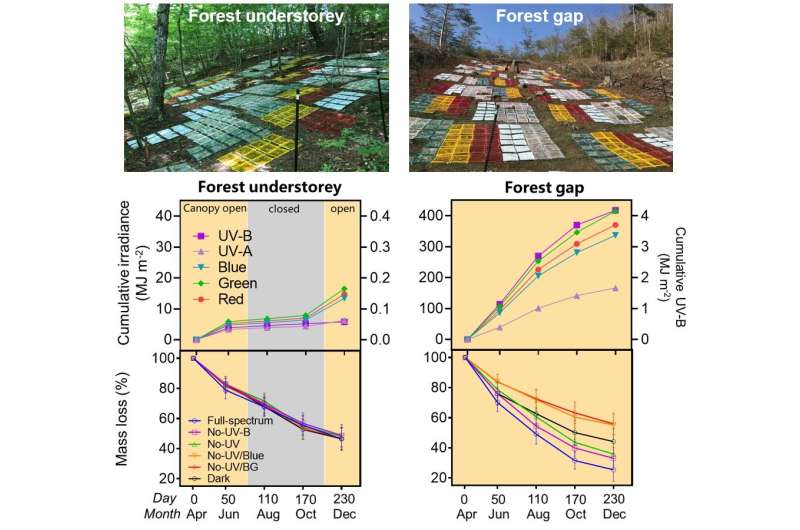Solar radiation accelerates carbon cycle process of temperate forest ecosystems

Litter decomposition is critical for carbon (C) cycling in terrestrial ecosystems. Sunlight, as the essential energy for the biogeochemical cycling, can directly break down natural organic matter and accelerate decomposition through photodegradation. However, the role of photodegradation in litter decomposition has been neglected especially in productive mesic ecosystems, where litter is exposed to a heterogeneous radiation environment. Obtaining a more-complete picture of the drivers of litter decay is key to predicting how terrestrial C and nutrient cycles respond to climate changes.
Wang Qingwei from the Institute of Applied Ecology of the Chinese Academy of Sciences (CAS) conducted a large appropriate spectral attenuation experiment, collaborating with a couple of senior ecologists.
They calculated the contribution of solar spectral irradiance to decomposition in the understorey and an adjacent gap created by a clear-cut in a temperate deciduous forest.
One of the key findings is that photodegradation, driven by blue light (400-500 nm), unexpectedly contributed more to decay rates than other environmental factors.
"This project is the most comprehensive experimental manipulation of photodegradation to evaluate the contribution of spectral regions to litter decay rates. Our finding broadens the current comprehension, showing that photodegradation makes a ubiquitous contribution to decomposition, improving models that attribute C loss through decomposition to ecosystem processes," said Wang Qingwei.
They also made a model to estimate the effect of photodegradation on C loss at the ecosystem level, based on scenarios of forest harvesting or disturbance intensity. The modeling results indicate that photodegradation increases C loss by up to 63% relative to a continuous forest understorey, due to more cumulative solar irradiance on surface litter.
"This is the first to show that photodegradation significantly accounts for C flow back to the atmosphere from mesic forest ecosystems, consistent with its recent finding in dry grassland ecosystems. It means that photodegradation is the missing piece for accurately modeling decomposition in all terrestrial ecosystems, not just in the arid parts of the world," said Dr. Hiroko Kurokawa from the Forestry and Forest Products Research Institute (FFPRI), Japan.
This study has been published in New Phytologist, titled "The contribution of photodegradation to litter decomposition in a temperate forest gap and understorey."
More information: Qing鈥怶ei Wang et al. The contribution of photodegradation to litter decomposition in a temperate forest gap and understorey, New Phytologist (2020).
Journal information: New Phytologist
Provided by Chinese Academy of Sciences




















